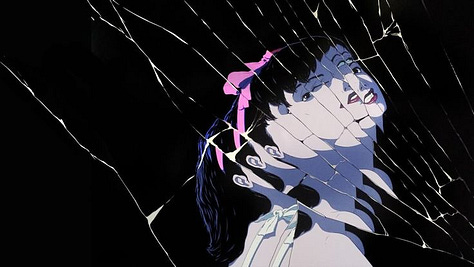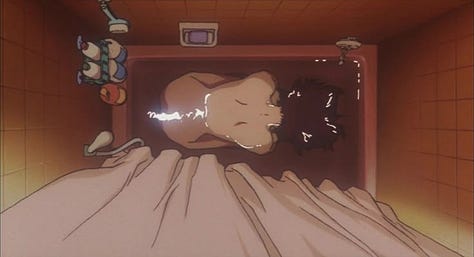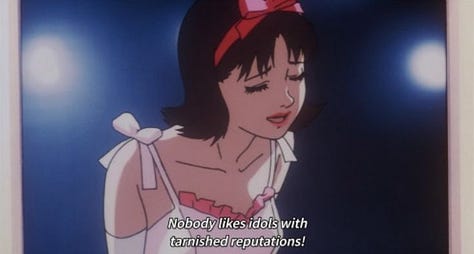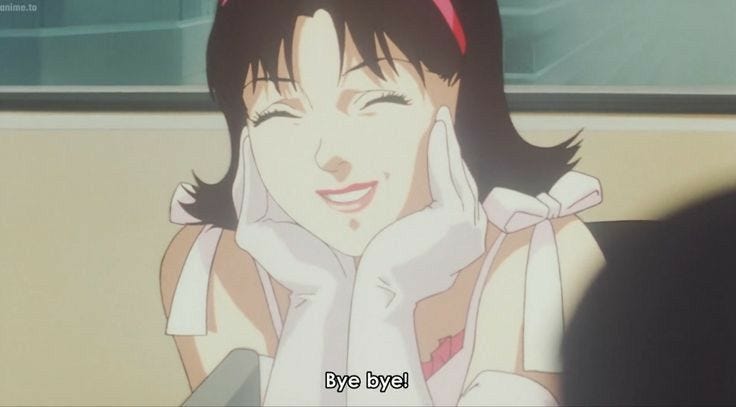The Slut Who Lived: Perfect Blue and the Girl Who Couldn't Say No
PART 4: The algorithm doesn't care if you break... the violence of gaze.
There’s a moment in Perfect Blue where Mima, wide-eyed and unraveling, stares into her reflection and asks, “Who are you?” It’s not poetic, it’s desperate.
That line… the staring at one’s reflection… we’ve all been there. Right? Because if you’ve ever had to reinvent yourself, you know what it’s like to look in the mirror and feel like a fraud. And if you’ve ever performed—online, on stage, on screen, or just in life—you know what it’s like to wonder which version of you people actually love.
That’s the horror of Perfect Blue. Not the blood, not the stalker, not the descent into madness—but the slow, bone-deep realization that you’ve lost control of your own narrative.
Directed by Satoshi Kon, Perfect Blue follows Mima Kirigoe, a pop idol who gives up her all-girl group career to become a “serious” actress. Her image is managed, curated, and consumed—until someone else starts managing it for her. A stalker begins chronicling her life through a fake blog that eerily knows things she doesn’t remember doing. An alternate “idol” version of her appears like a haunting. And violent crimes begin to follow her career change like a curse.
She’s being rewritten. By men. By fans. Bu fantasy. By a culture that confuses purity with worth.



Mima starts to fracture because she’s no longer allowed to define herself.
That can be a familiar feeling. Especially if you’ve ever tried to shapeshift out of survival. If you’ve ever gone from one identity to another and watched how people either praised or punished you. If you’ve ever been slut-shamed, sainted, or stalked for daring to change.
Perfect Blue is one of the most honest depictions of what happens when you perform femininity so well you become a stranger to yourself. Mima is punished for evolving. She’s punished for desire. She’s punished for breaking the image other people wanted for her. Hmmmmmm… I could name some similar stories!
That’s what horror does best—it takes cultural fear and makes it literal!
In this case:
The fear of losing control of your body and image.
The fear of being invisible and hyper-visible.
The fear that your most curated self is more real than your inner one.
What’s so terrifying is that the “other Mima” isn’t a ghost or demon—it’s an idea. A projection of who she shouldn’t be. Someone prettier, thinner, more obedient. A version of herself who smiles like an idol, never gets angry, never gets messy, never says no.
She floats… She mocks her… She’s loved more.
That’s the most dangerous version of yourself… the one EVERYONE ELSE PREFERS.



I can be honest enough to admit with you that I’ve felt like Mima. In the industy. On the internet. In relationships where I was rewarded for being pretty but punished for being difficult… or being ambitious… for being real.
My best friend said recently when it comes to the internet “I no longer want to be perceived.” And I thought about it a while… I mean really thought about it. There’s a particular trauma that comes from being perceived constantly, especially as a woman. From having your worth tangled up in being visible, desirable, clickable. From waking up and realizing your reflection feels like a performance someone else directed. And worse, they liked it better.
Perfect Blue doesn’t give Mima peace. It gives her survival, which is something scarier. Because surviving that kind of breakdown means learning to live with fragmentation.
But here’s the twist—the horror doesn’t win.
She crawls her way back. She stitches herself together. In the final scene (and don’t get mad at me for spoilers…this came out in 1997!), when someone doubts her identity, she smiles in the mirror and says “No, I’m the real thing.”
And I believe her. Because even if she’s changed, even if she’s cracked—she chose it. And that choice is everything.
That’s what it means to be The Slut Who Lived. Not untouched. Not undamaged. Still standing and still real.






